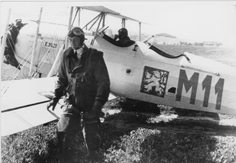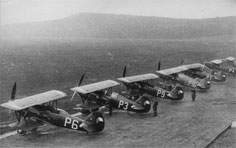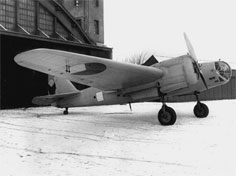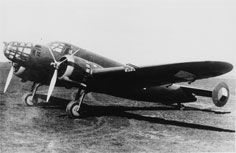EXPO CZECHOSLOVAK AIR FORCE 1918 – 1939
PANEL VIII
 |
The float-version of the production S-328 type amounted two machines only. These ones were used for target- tug duties over the Adriatic Sea in the Boka Kotorska Region, where gunnery was practised the Czechoslovak artillery. Handling Characteristics was not deteriorated by fitting the floats and that reason for neither center of gravity nor the fin was in the need of mounting. Made in the 1925-1926 period.
An No IV batch Avia B-534 fighter biplane. The cockpit was covered by a canopy and hooded wheels. Aircraft of all the batches were equipped by racks for small splinter bombs.
Performance : Maximum speed 375 km.p.h., climb ratio 15 mps, range 600 km, service ceiling 9500 m |
An No IV batch Avia B-534 fighter biplane. The cockpit was covered by a canopy and hooded wheels. Aircraft of all the batches were equipped by racks for small splinter bombs.
Performance : Maximum speed 375 km.p.h., climb ratio 15 mps, range 600 km, service ceiling 9500 m |
 |
 |
An 190th production B-534 fighter, the fourth one armed by four machine guns. The machines being turned out from the 1936 year were of higher empty as well as take-off weight, top speed, service ceiling and climb up to 5 000 m. Two machine guns typical for the first 100 pcs batch in the lower wing were mounted into both sides of the fuselage. |
A prototype of S-431. This type was not production one at all.
Dimensions : Span 10.06 m, length 7.9 m, empty weight 1310 kg
Powerplant : a 680 Siddeley Tiger, wooden two-blade propeller compared with S-331
Performance : Top speed 370 km/p/h, climb to 5 000 m in 6 min 58 sec, service ceiling of 9 500 m |
 |
Praga E-39.21, the 21st production one, the batch powered by a Walter Gamma engine. There were several kinds of powerplant used for this type. A shot of a flying instructor. M stands for the No 1 Training Flight. In several cases the code name of BH-39 after her designers Benes and Hajn is used in this type. Militarily coded by the letter E. |
 |
Recce S-228, 328 and 528 types as well as S-231 fighter, S-32 transport- and S-39 and S-239 sporting planes were turned out by the Letov Company in the 1931-1938 period.
The Aero Aeroplane Works built two prototypes of a A-102 fighter and production A-46 trainers, A-100, A-101, Ab-101 recce-bomber biplanes as well as A-304 monoplanes used for observing duties, A-300 monoplane bombers powered by the British Mercury IX engines, licensed Marcel Bloch MB-200 obsolete bombers and also licensed SB-2s in this time frame.
The A-304 type attained the top speed of 325 km/p/h. Fifteen planes built till the German occupation on March 15, 1939 were confiscated by the Germans and sent to kin countries, above all to Bulgaria.
An A-300 bomber reaching the maximum speed 470 km.p.h.and able to accommodate bombload of 1 000 kg
was tested by the Fockewulf Plant in Bremen and later scrapped.
Compared with the pointless purchase of the MB-200 licence when strings were pulled by politicians, the Soviet-licensed SB-2s were incomparably more advanced. Top speed achieved by Czech made “Katyushkas ” was nearly by 200 km/p/h higher compared with MB-200s.
Fourty five machines of this type built by the Aero Works were used by Luftwaffe or sent to Bulgaria. The B-71s were powered by Czech-made 680 Avia-Hispano Suiza engines and were able to accommodate the bombload of 600 kg under their wings.
As B-34+B-534 fighters, specially built Av-122+Av-122a aerobatic planes, licensed Fokker VII+F IX D trasporters + F IX bomber as Rohrbach licensed Av-46 and Soviet SB-2 one of B-71 were turned out during 1931- 1938 by the Avia Company. In addition, only
three prototypes of the fixed-undercarriage-B-35 fighter attaining the maximum speed of 495 km/p/h were built here and a twelve pcs-batch of the B-135 fitted by a retractable undercarriage was made and sent to Bulgaria in the 1941 year.
There were built 70 production MB-200s there and later two batches of the B-71 bomber – 40 and 26 machines respectively. 30 SB-2s were purchased by the Czechoslovak Republic from the Soviet Union and in 1936 also their licence. The Avia-built B-71 fitted by here developed new tubullar radiators reached the speed by 15 km/p/h higher. Our idea was copied by the Soviets and brought into use in the SB-3 type. After the German occupation were the B-71s converted to target towing configuration.
Because all three Aeroplane Works within a range of German bombers were, a new plant was built at the village of Kunovice in South Moravia. B-534s were turned out here even in the year of 1937.
In the 1931-1938 time-frame planes were mass-produced also in the CKD Prague-Karlin Works, Studenka, Otrokovice and Chocen – in Karlin BH-39NZ, BH 39 G, BH-39AG, BH-41 and E-241 trainers + E-114 B and E-144G sporting planes. In Otrokovice Z-XII, at Studenka T-1 and T-101 and at Chocen B-60, B-50 and B-150 types.
 |
An Avia Ba-422 was specially built in the two-pcs batch on the occasion of the 1938 France Aeronautical World Championship. The upper wing was lowered at the fuselage-width so that the pilots could see properly while flying in a diverted position.
Czech aeronaut František Novak raked at St. Germain 806 points at first, ahead of an German Hagenburg by 21 and a French pilot Cavalli by 122 ones.
The verdict of the jury was later changed in favour of Hagenburg – Novak was was penalized for would be extending time limit. Also under these circumstances bravado was shown by the King of the Air and reacted with smile.
Span 8.85 m, length 6.80 m, empty weight 903 kg
Powerplant : an 440 hp Avia Rk-17 engine
Performance : service ceiling 7000 m, range 460 km |
The first prototype of an Avia B-35 fighter was fligt-tested during the September 1938 Mobilization. NOTE : Too late.
Fuselage : screwed and riveted steel-tube-structure, covered by fabric, from the cockpit forwards covered by removable aluminium sheet plates Wings comprised two wooden longerons, wooden skeletal structure and covered by a thin alclad sheet.
. |
 |
 |
The first prototype of an Avia B-35 monoplane on which Sgt. Kavalec lost his life. Aircraft`s performance was influenced by the fix hooded undercarriage. The version of the B-35 type with retractable undercarriage was brought in complexion after the Germans occupied the Czech and Moravian Lands on March 15, 1939, coded as B-135. Twelve planes of this type as well as the B-135 licence was bought by a Bulgarian-pro-Nazi puppet regime.
Powerplant : a 750 Avia Hispano Suiza 12 Ycrs, two-blade wooden or composite propeller
Performance : Maximum speed 495 km.p.h., climb ratio 13 m/p/s, range 550 km, service ceiling of 8500 m
Armament : two synchronized machine guns |
 |
Avia B-534 fighters assigned to the Prague Flight under 1938 Mobilization in Eastern Slovakia / courtesy of Martinek /. In addition to two side-fuselage-mounted machine guns, the Bk-534 type was armed also by a HS No 402 via propeller-axle shooting canon.
Empty weight : 1631, loaded one of 2222 kg respectively
Powerplant : an Avia HS 12 Ycrs engine
Performance : Top speed 375 km.p.h., range 500 km, rate of climb 15m/p/s, service ceiling of 9500 m |
| Fotografie čs. bombardovacího letounu Avia B-71 představuje sovětský originál z konstrukční dílny Andreje Tupoleva ANT 40.2 SB-2 (Skorostnyj Bombardirovščik), na jehož vývoji se podílel konstruktér A. A. Archangelskij. Československé letectvo mělo těchto letounů 60 a jeden kus ve výzkumném ústavu. Sériová výroba byla zahájena v Avii a do okupace nebyl vyroben ani jediný exemplář, rozpracované letouny dokončili Němci. Připravovaná výroba v Letovu nebyla vůbec zahájena. |
 |
 |
Aero A-300 prototyp bombardovacího letounu s anglickými motory Bristol Mercury IX (každý o výkonu 830 hp) byl zalétán až v roce 1938. Max. rychlost 470 km/h, dolet 900 až 2200 km, dostup 8300 m, stoupavost do 5000 m za 9 min 4 sekundy. Prázdná hmotnost 3955 kg, rozpětí 19,2 a délka 13,5 metru. Prototyp A-300 Němci zabavili a sériová výroba zahájena nebyla. |
[
TOP ] [
Zpět ]











